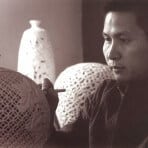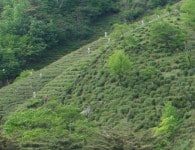A couple of weeks ago on our new Facebook page I posted the above image of Park Jong Il. That post received more than 700 hits, more than three time the number of hits on its nearest competetor and more than five times the average. As you can see we’re not a well known Facebook page yet but for us that is impressive. However, I’m sure those who saw and shared it shared it for many reasons. But they should have been sharing it for just one. Park Jong Il is one of just a very few remaining teaware artists that understands the heart and soul of Korean tea and teaware. He is one of a rare few who have been able to tap into the true spirit of the teaware masters of old whose work are so highly revered today – especially in his teapots. Sure on occasion he adds a whimsical knob or will even play with form but underlying all of that is a ‘jangin’ master. He is naturally full of the spirit of clay of Tea and teaware.
Those who know Korean art deeply know there is one overriding eternal basic philosophical and aesthetic position – the work must be natural.
Four years ago on January 7, 2010 I first introduced our friend Park Jong Il to the Western Tea World. Or at least I began writing about him and his work on our Morning Crane Tea blog. Over the years I have sold his work to tea connoisseurs from many countries. I have had many, including Chinese tea connoisseurs, tell me that prefer his teapots over YiXing. Recently a tea connoisseur and author of his own tea blog posted on our Facebook page and showed a tea set by Park Jong Il. He had recently purchased from us. Reflecting the responses from many, the blogger wrote:
My favorite set of Korean teaware! This may sound odd but I find Korean tea and teaware much more ‘pure’ than its Chinese, Japanese, or Taiwanese counterparts.(1)
That is how it should be. True Korean ware is pure and direct. Park Jong Il’s work is pure and direct and natural. The internationally known Japanese ceramic artist and Intangible Cultural Treasure Hamada Shoji once said, “I think there are hardly any pots in the world through which a people’s life breathes more directly as Korean ones, especially Yi Dynasty(2) wares. Between pots and life, Japanese ones have “taste”, Toft wares have “enjoyment”, even the Sung pots have “beauty”, and so on. But the Yi dynasty pots have nothing in between; peoples’ lives are directly behind the pots.[3]
As you review this blog and are introduced to Park Jong Il’s work and family you will soon realize that Park Jong Il’s life breathes directly through his work.
If you are interested in a teacup, teapot, chawan or simply want to taste one of his favorite teas, contact us.
(1) This particular teaset by Park Jong Il is one of his newer but simpler styles.
(2) The term Yi dynasty was often used by the Japanese in reference to the Choson or Joseon dynasty. The Yi family ruled Korea throughout the length of the dynasty.
(3) From Hamada Potter by Bernard Leach, Kodansha International




























1 Comment
While teaching Korean tea ceremony in Kyoto, Japan, I found that the Japanese who came to my tea house very much preferred the Korean style, which is less “manufactured”, in a way. The movements in the Korean ceremony are purely functional, in order to bring boiled water to a specific, perfect temperature. Implicit in this is the idea that the person offering the tea must know the tea ware, particularly containers that will be used for water.
As a part of my training I had to study with my tea master, Kim Kyung-ui (Cho Inmok, Gyeonggi-do, Icheon-si), not only teas and ceremony, but also about clay, and the history of Korean pottery. She also took me to observe Chinese tea masters in Korea, and we studied the philosophy of the Japanese ceremony, as well. This intense process of discovery really instilled in me the importance of knowing the interconnectedness of tea and the pottery and artistry that goes into producing all of the implements that we require to make good tea.
Thank you for providing this space for me to keep up on things.
G